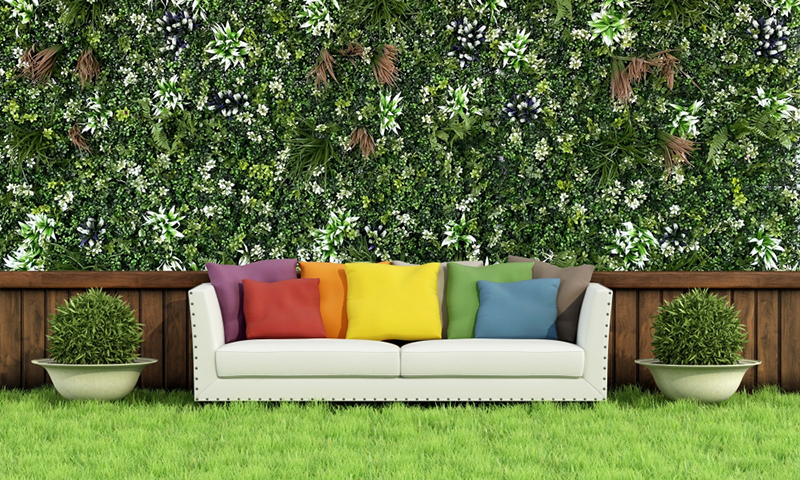Climbing Plant Design for 3D Artificial Vertical Gardens: Creating Lush, Dynamic Wall Displays with Faux Vines and Trailing Species
Artificial vertical gardens offer a unique canvas for incorporating the natural elegance of climbing plants without the challenges of real vines, such as pruning, pest control, or structural damage. By using designs inspired by a variety of climbing species, these gardens can introduce vertical movement, texture, and a sense of organic growth to any space. Below are strategies for designing 3D artificial vertical gardens with climbing plants that mimic the beauty of their living counterparts.

Real climbing plants use different strategies to ascend structures, such as twining stems, tendrils, aerial roots, or adhesive pads. Artificial designs can replicate these growth habits to create a more authentic and dynamic appearance.
Twining Stems for Graceful Curves: Use artificial vines with flexible, spiraling stems, such as those inspired by morning glories or honeysuckle, to create flowing, organic shapes. These designs work well when wrapped around vertical supports or draped over the edges of the garden, adding a sense of movement and softness.
Tendrils for Delicate Detail: Incorporate artificial plants with thin, coiling tendrils, like those resembling peas or grapes, to add intricate texture and visual interest. These elements can be intertwined with other vines or left to dangle freely, creating a more natural and untamed look.
Aerial Roots for a Tropical Feel: Introduce artificial climbing plants with thick, root-like structures, such as those inspired by philodendrons or monsteras, to add a bold, tropical aesthetic. These designs can be attached to the wall or allowed to hang down, creating a sense of depth and dimension.
Climbing plants come in a wide range of leaf shapes and sizes, from tiny, heart-shaped foliage to large, lobed leaves. By mixing different types of artificial leaves, you can create a more diverse and visually appealing display.
Small, Heart-Shaped Leaves for a Delicate Look: Use artificial vines with tiny, rounded leaves, such as those resembling ivy or clematis, to add a sense of lightness and airiness. These designs work well as fillers between larger leaves or when draped over the edges of the garden.
Large, Lobed Leaves for Dramatic Impact: Incorporate artificial climbing plants with broad, deeply cut leaves, like those inspired by split-leaf philodendrons or Swiss cheese plants, to create a bold focal point. These designs can be placed at eye level or in central positions to draw attention.
Fern-Like Fronds for a Textured Backdrop: Introduce artificial vines with feathery, divided leaves, such as those resembling asparagus ferns or Boston ferns, to add texture and depth. These designs work well as a backdrop for other climbing plants or when used to fill larger gaps in the arrangement.
While most climbing plants are known for their green foliage, many species feature striking variegation or seasonal color changes. Artificial designs can draw from this natural diversity to create a more lively and engaging garden.
Solid Green Leaves for a Classic Look: Use artificial vines with uniformly green leaves, such as those inspired by English ivy or pothos, to create a timeless and elegant display. These designs work well in formal spaces or as a neutral backdrop for bolder elements.
Variegated Leaves for Visual Interest: Incorporate artificial climbing plants with leaves that feature streaks, spots, or edges of white, cream, or yellow, like those mimicking variegated ivy or philodendrons, to add texture and break up solid blocks of green. These patterns create a more dynamic and eye-catching display.
Seasonal Color Accents for a Pop of Vibrancy: Introduce artificial vines with leaves in shades of red, purple, or bronze, such as those resembling some types of creeping fig or Japanese maple, to add warmth and depth. These colors work well in autumnal-themed gardens or as accents against lighter backgrounds.
In natural settings, climbing plants often grow in layers, with some species occupying the foreground, others the middle ground, and still others the background. Artificial gardens can replicate this layering effect to create a more immersive and three-dimensional display.
Foreground Climbers for Detail and Intimacy: Place shorter artificial vines, such as those resembling creeping thyme or baby’s tears, in the front of the arrangement. These designs draw viewers in and add a sense of closeness to the garden.
Middle-Ground Climbers for Volume and Balance: Use medium-height artificial vines, like those inspired by jasmine or passionflowers, to fill out the middle sections of the garden. These plants create a sense of fullness and connect the foreground to the background.
Background Climbers for Height and Structure: Incorporate taller artificial climbing plants, such as those resembling wisteria or bougainvillea, in the back of the arrangement. These designs provide a sense of scale and frame the entire garden, making it feel more expansive and complete.
By focusing on realistic growth patterns, leaf variety, color contrast, and layered arrangements, artificial climbing plants can transform 3D vertical gardens into vibrant, low-maintenance displays. Their durability and adaptability make them ideal for any space, ensuring year-round beauty without the need for sunlight, water, or ongoing care.
Contact: Amy
Phone: 86-15311787313
E-mail: info@foszmac.com
Whatsapp:86-15311787313
Add: Fengtai District, Dacheng Road, No.24 Building, Room 203, Beijing, China